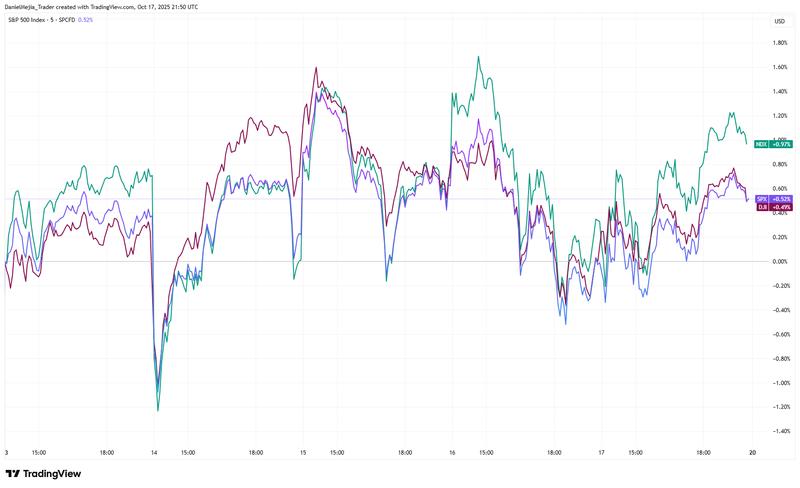US indices rise on easing trade tensions
Easing commercial tensions between the United States and China, together with broadly resilient bank earnings, supported a weekly recovery in major US equity indices. At the same time, the Bank of England signalled that interest-rate cuts may need to be implemented more slowly amid persistent inflationary pressures.

President Donald Trump said that a 100 per cent tariff increase would not be sustainable, while pressing China to curb controls on rare-earth exports.
Major US banks reported third-quarter revenues and earnings per share above analysts’ estimates.
Bank of England Chief Economist Huw Pill warned that “Interest rates probably need to be cut more slowly because inflation pressures in the United Kingdom economy”.
Eurostat reported core inflation of 2.4 per cent year-on-year in the EU, above expectations, while headline inflation remained unchanged at 2.2 per cent.
Positive weekly balance in US major indices amid easing trade tensions
Major US indices posted a positive weekly performance as market participants responded to signs of a de-escalation in US–China trade tensions and to generally robust third-quarter bank results.
Reuters reported that President Donald Trump stated a 100 per cent increase in tariffs on Chinese goods would not be sustainable; he nevertheless continued to press China on restricting controls over rare-earth exports. In turn, the Director-General of the World Trade Organization emphasised the importance of de-escalating trade tensions, warning that a sustained decoupling between the United States and China could harm the global economy. Markets have been looking to the forthcoming meeting in South Korea between President Trump and President Xi Jinping as a potentially decisive moment for commitments on trade.
US banks also contributed to the positive tone: JPMorgan, Wells Fargo, Goldman Sachs, BlackRock, Citigroup, Bank of America, Morgan Stanley, Charles Schwab and American Express reported revenues and earnings per share above analysts’ estimates for the third quarter.
On the day, the US major indices recorded an average gain of 0.57 per cent. Despite intra-week falls, the weekly balance was positive: the Dow Jones rose 0.49 per cent to 46,190 points, the S&P 500 was up 0.52 per cent to 6,664, and the Nasdaq recorded a weekly gain of 0.97 per cent to 24,817 (see Figure 1).

Figure 1. S&500, Nasdaq100 and Dow Jones (weekly balance). Source: data from the NYSE Exchange and Nasdaq Exchange. Own analysis conducted via TradingView.
BoE: interest-rate cuts should be applied slowly amid inflationary pressures
The Bank of England’s Chief Economist, Huw Pill, told markets on Friday that “Interest rates probably need to be cut more slowly because inflation pressures in the United Kingdom economy”. The UK’s headline inflation rate stands at 3.8 per cent year-on-year, with core inflation at 3.6 per cent — both materially above the Bank’s 2 per cent target. At the same time, labour-market indicators show signs of weakening: the unemployment rate has risen to 4.8 per cent, its highest level since July 2021.
The combination of above-target inflation and a softening labour market presents a policy dilemma for the BoE as it seeks to balance price stability against support for employment. Market participants reacted to the remarks with a slight depreciation of sterling: the pound fell approximately 0.05 per cent against the US dollar to 1.3424, while the FTSE 100 declined 0.86 per cent to 9,354 points.
EU core inflation surprised to the upside
Eurostat released inflation data showing that core inflation in the European Union accelerated to 2.4 per cent year-on-year, slightly above consensus expectations of 2.3 per cent. Headline inflation remained unchanged at 2.2 per cent, in line with forecasts.
Although the rise in core inflation indicates modest upward pressure, the overall rate remains close to the European Central Bank’s target. ECB President Christine Lagarde has previously noted that these levels are consistent with a healthy and balanced demand profile. Nonetheless, the euro weakened against the dollar on the data release, depreciating by about 0.29 per cent to approximately 1.1650 at the close.
